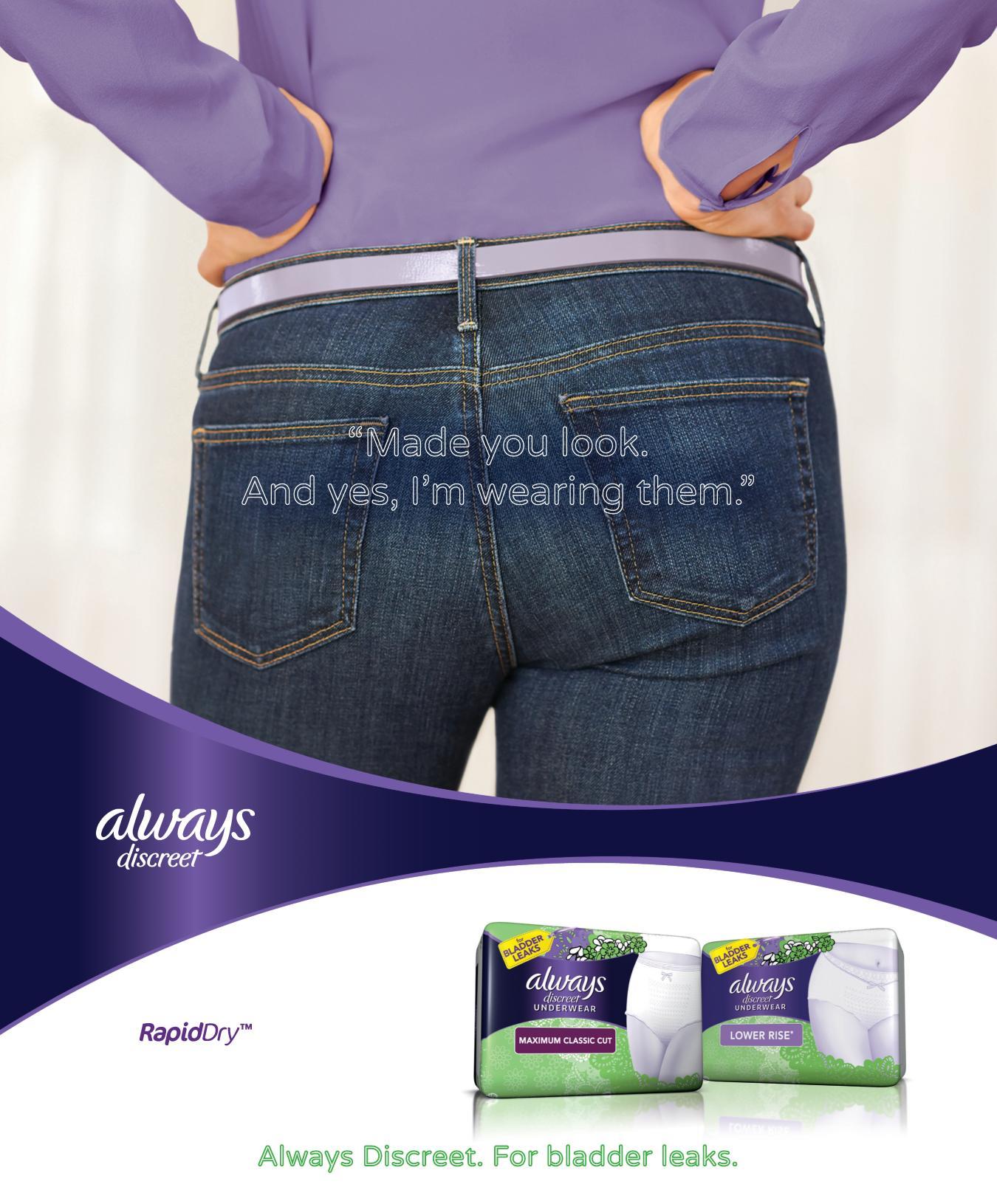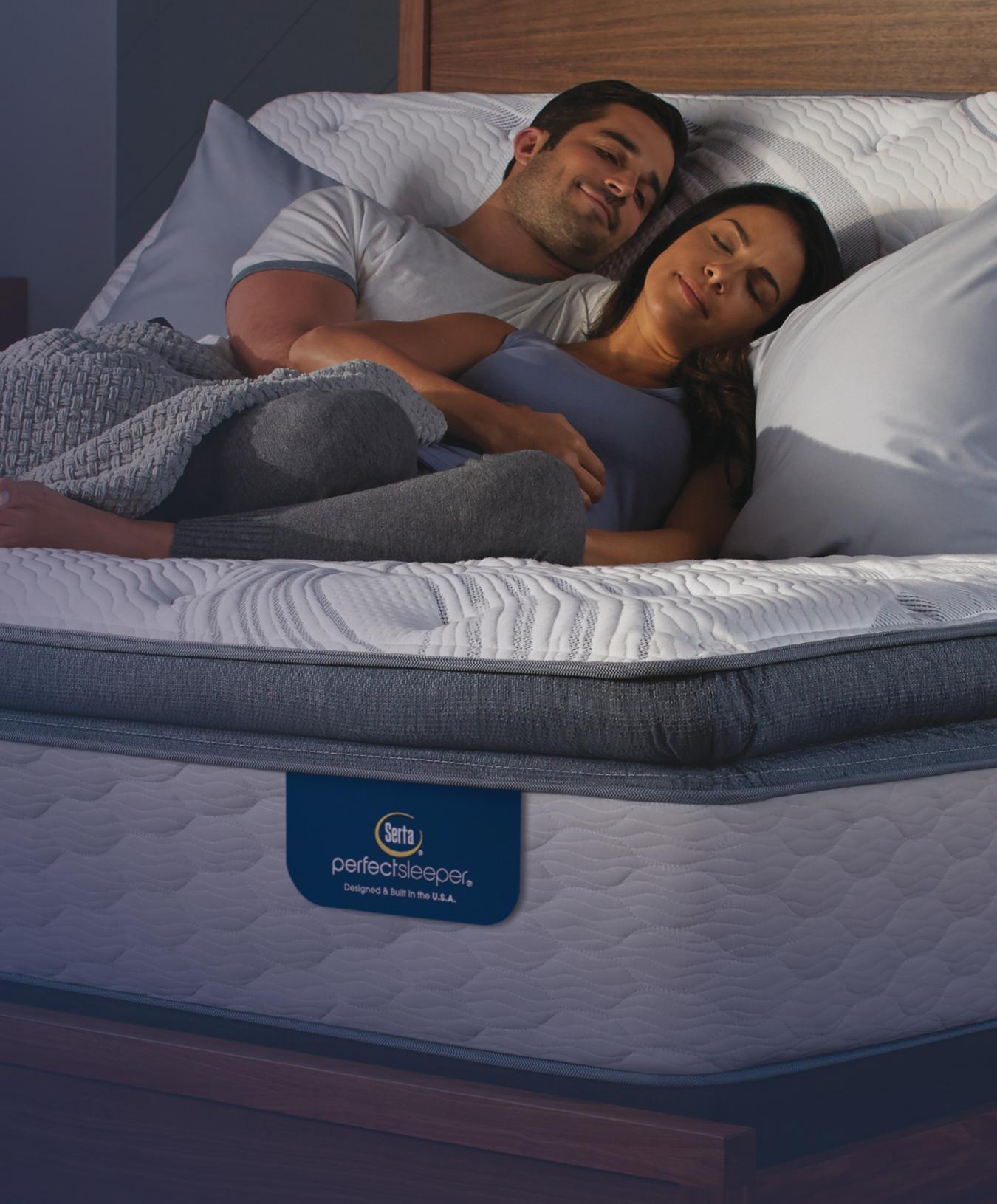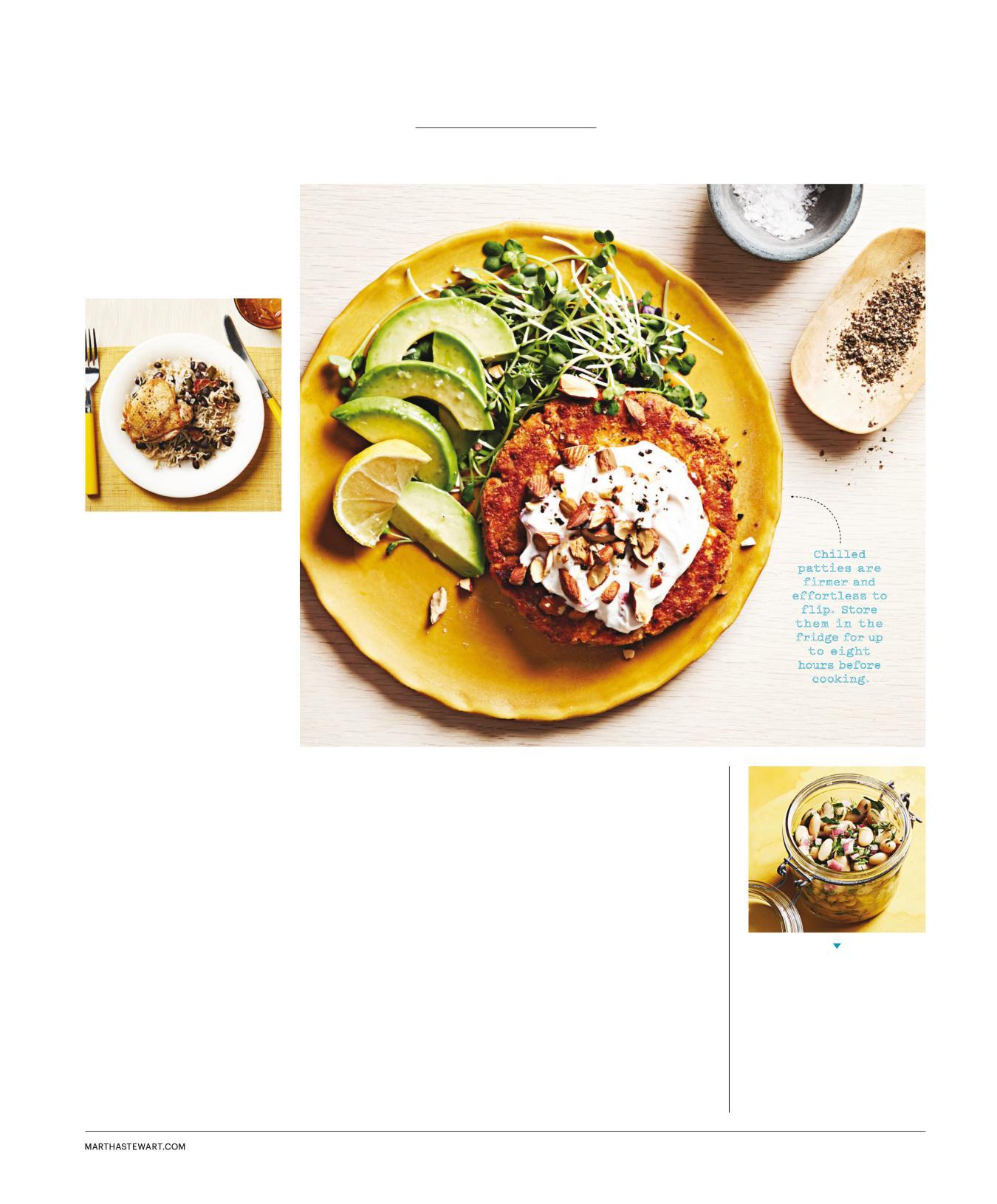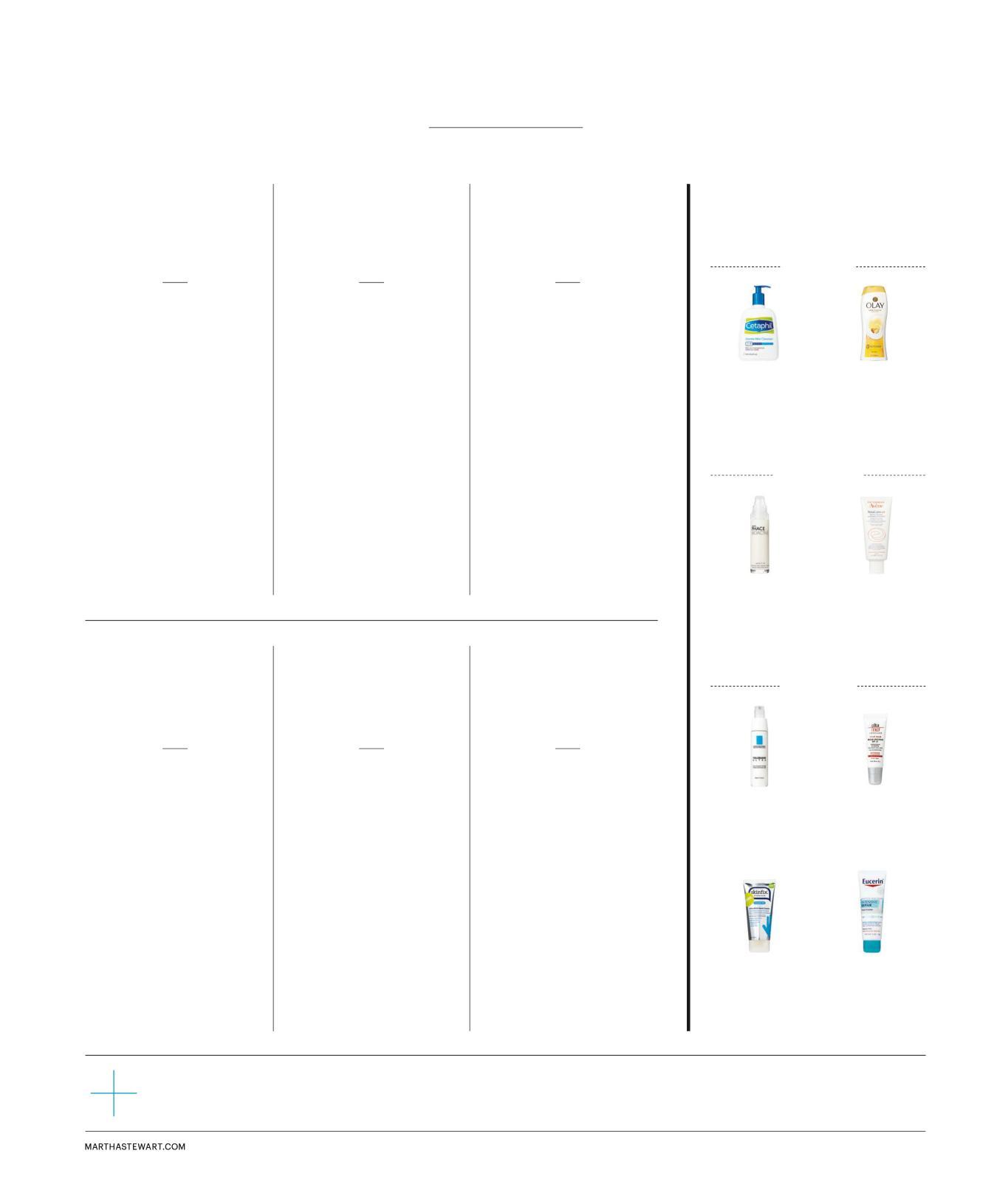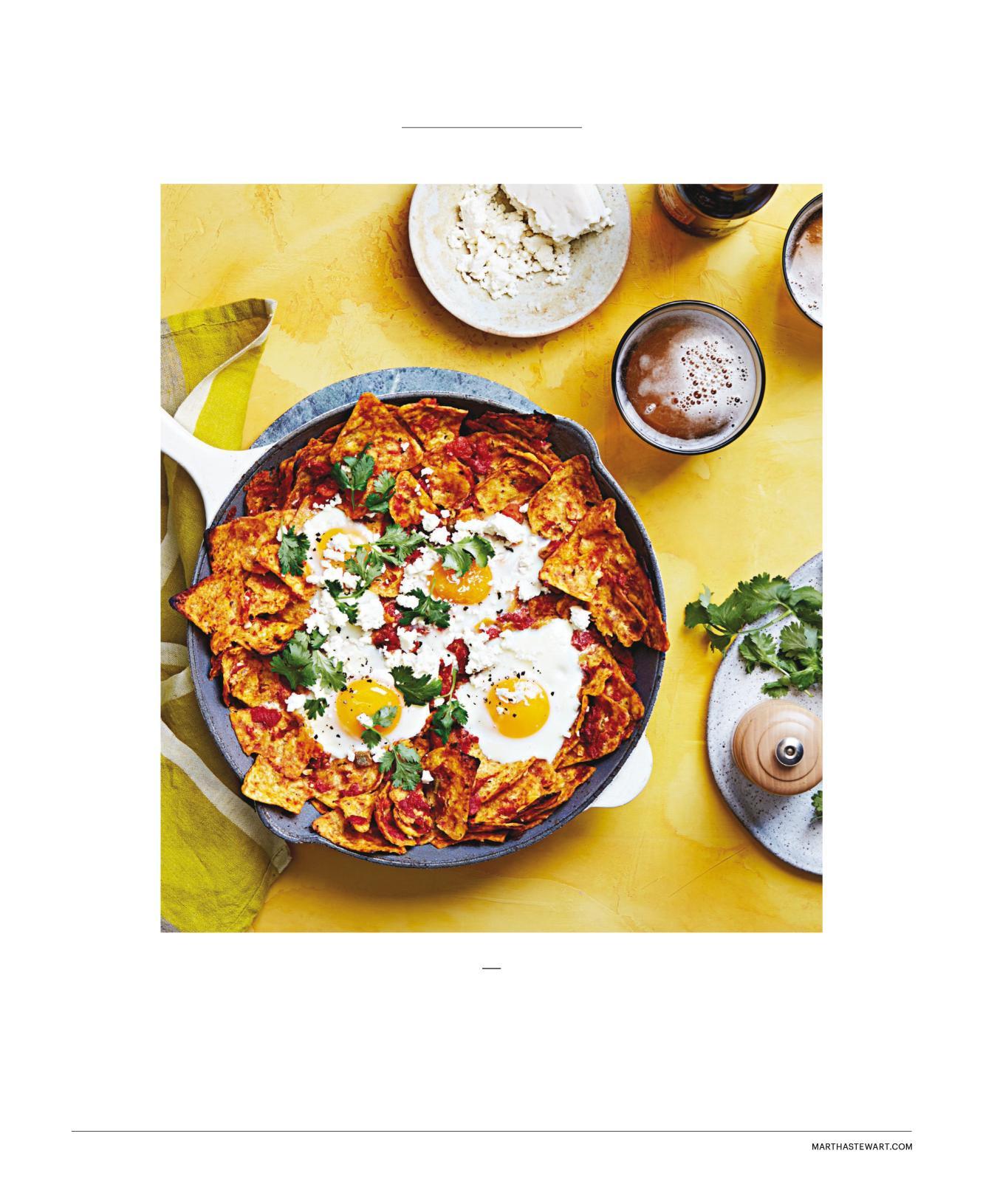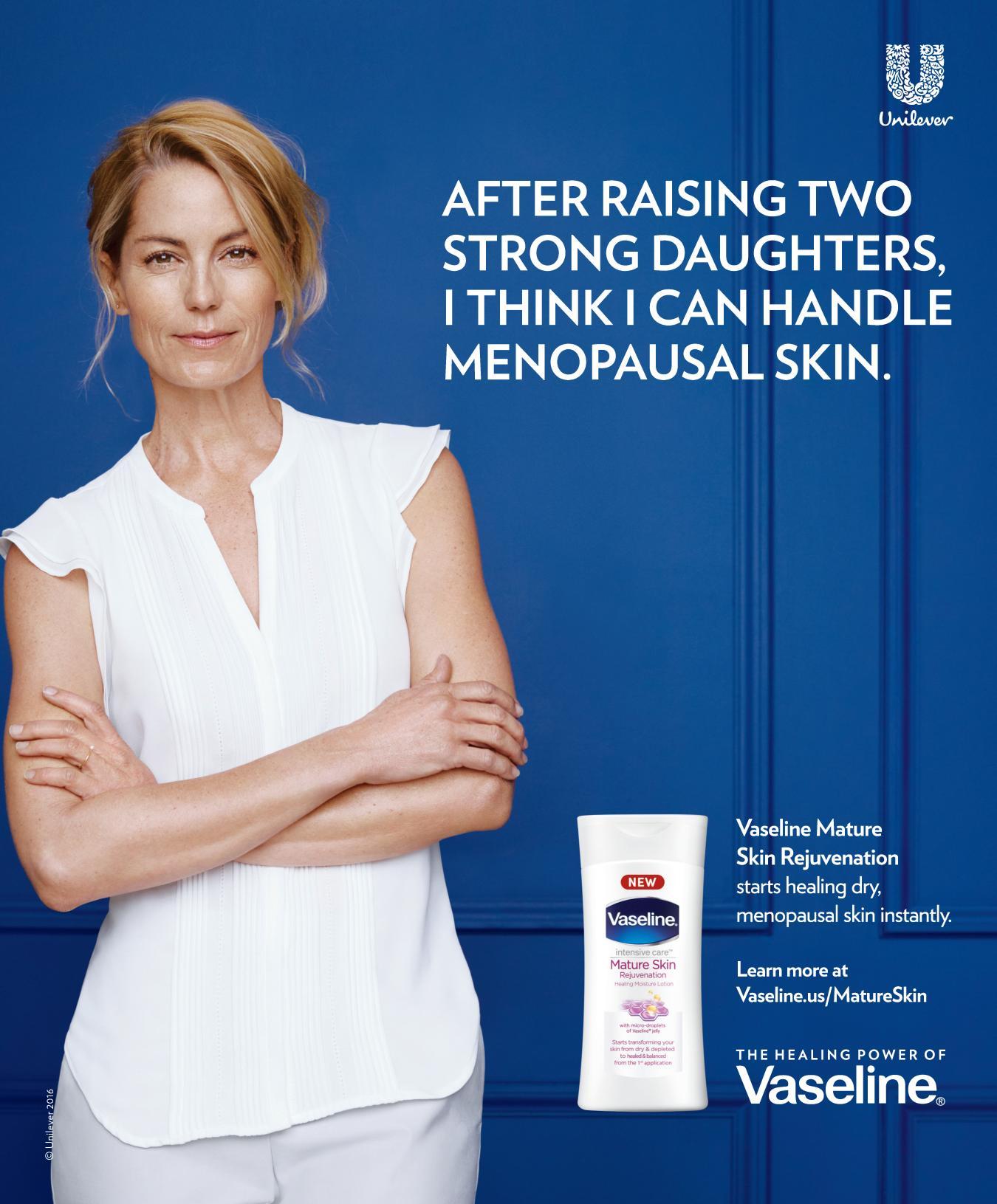
9 minute read
Health
GOOD LIVING
You work out a few times a week. You eat salads and steer clear of the drive-thru. You get seven hours of sleep (on most nights), and you’re okay with your weight (on most days). As long as your pants fit and your energy’s up, you—like most people—probably assume you’re on the right track healthwise. But your doctor analyzes a collection of different gauges to get the full story, because no single measurement is a perfect indicator on its own. These are the ins and outs of the most important measures, and how they help doctors monitor changes over time and spot risks before they get serious.
Advertisement
BODY MASS INDEX
BMI measures body fat based on height and weight. It’s been used to define a healthy weight for decades, and it’s still one of the first numbers your doctor will record as a solid starting point each time she sees you. The normal range is 19 to 25. If your BMI is lower or higher, your doc will talk with you about your diet and exercise habits. THE CAVEAT: A normal BMI doesn’t necessarily put you in the clear, since its meaning varies depending on body type, lifestyle, and factors like family history. “If you have a poor diet and never exercise, you may not be healthier than someone who is five pounds overweight but has more muscle mass and follows a clean diet,” says Amber Tully, M.D., assistant professor of family medicine at the Cleveland Clinic.
FINE-TUNE IT: Wrap a tape measure around your waist. “If someone has a high BMI, but her waist circumference is in a normal range and her weight is evenly distributed, she’s likely to be healthier than a person who has a disproportionate amount of fat around her waist,” Tully says. Research shows that a large midsection greatly increases the risk of dia- betes and hypertension. In fact, a 2016 review of 12 studies revealed that every 10-centimeter increase was associated with a nearly 30 percent higher chance of heart failure. Women should aim to keep their waist circumference stable, below 35 inches.
BLOOD PRESSURE
Healthy blood pressure clocks in at or under 120/80 milligrams of mercury (mmHg). Systolic blood pressure, the top number, measures how much force your blood exerts against your arterial walls each time your heart beats; diastolic blood pressure, the bottom one, measures how much it exerts in between. “I look at an elevated blood pressure very strongly, because it’s a risk factor for heart attack and stroke,” says Tully. THE CAVEAT: For a young person with few indications of cardiac trouble, there may be other culprits behind high blood pressure. Anxiety or stress can falsely inflate it, as can taking certain stim- ulant medications, like those for ADHD, or even drinking a few cups of coffee before you head to your appointment.
FINE-TUNE IT: Monitor your BP over time. One elevated reading is concerning, but it isn’t necessarily a reason to panic, says Lori Tishler, M.D., medical director of the Phyllis Jen Center for Primary Care at Brigham and Women’s Hospital at Harvard Medical School. “If someone has high or borderline blood pressure, I want more than one measure,” she says. “Before you make a hypertension diagnosis, you want to have three elevated blood pressures over a short period of time, up to a few months.”
CHOLESTEROL
We need these fatty lipoproteins to help produce hormones, build tissue, and aid the liver. But too many do more harm than good: Research has shown that when your total cholesterol score—which is made up of LDL (the so-called “bad” cholesterol), HDL (the “good,” artery-scrubbing kind), and 20 percent of your level of triglycerides (common body fats, stored for energy in the bloodstream)— passes the 200 mg/dL mark, you increase your chances of heart attack or stroke. Ideally, you want HDL between 40 and 60, and LDL below 100—the lower, the better. THE CAVEAT: It’s not quite so simple anymore. Doctors are much more concerned with how your HDL and LDL stack up individually. “There’s a lot more emphasis on HDL,” says Tully. “HDL is cardioprotective, and we want that to be as high as possible. We look closely at the breakdown of numbers, not so much the total. You could have a high total choles- terol with good individual numbers, so that can be deceiving.”
FINE-TUNE IT: A total cholesterol score under 200 is still optimal— and you want to stay under that mark while keeping your HDL and LDL levels where they should be. Need to slash your total and raise your HDL? Cardiovascular exercise and omega-3 fatty acids (via eating oily fish like salmon at least twice a week, or taking supplements) are the best ways to bump up that number. Keep in mind that high HDL alone isn’t enough to cut cardiovascular risk, according to new research: One recent study, published in Circulation, found that for HDL to have a protective effect, LDL and triglyceride levels must be low (100 mg/dL or less); it didn’t have that impact when they were high. For the best protection against heart disease, balance all your numbers.
FITNESS
Two and a half hours of moderateintensity aerobic exercise per week is the minimum amount the U.S. Department of Health & Human Services prescribes for adults between 18 and 64. The goal isn’t just to maintain a healthy weight; lack of physical activity can increase your risk of cardiovascular disease and shorten your life span.
It only takes a second...
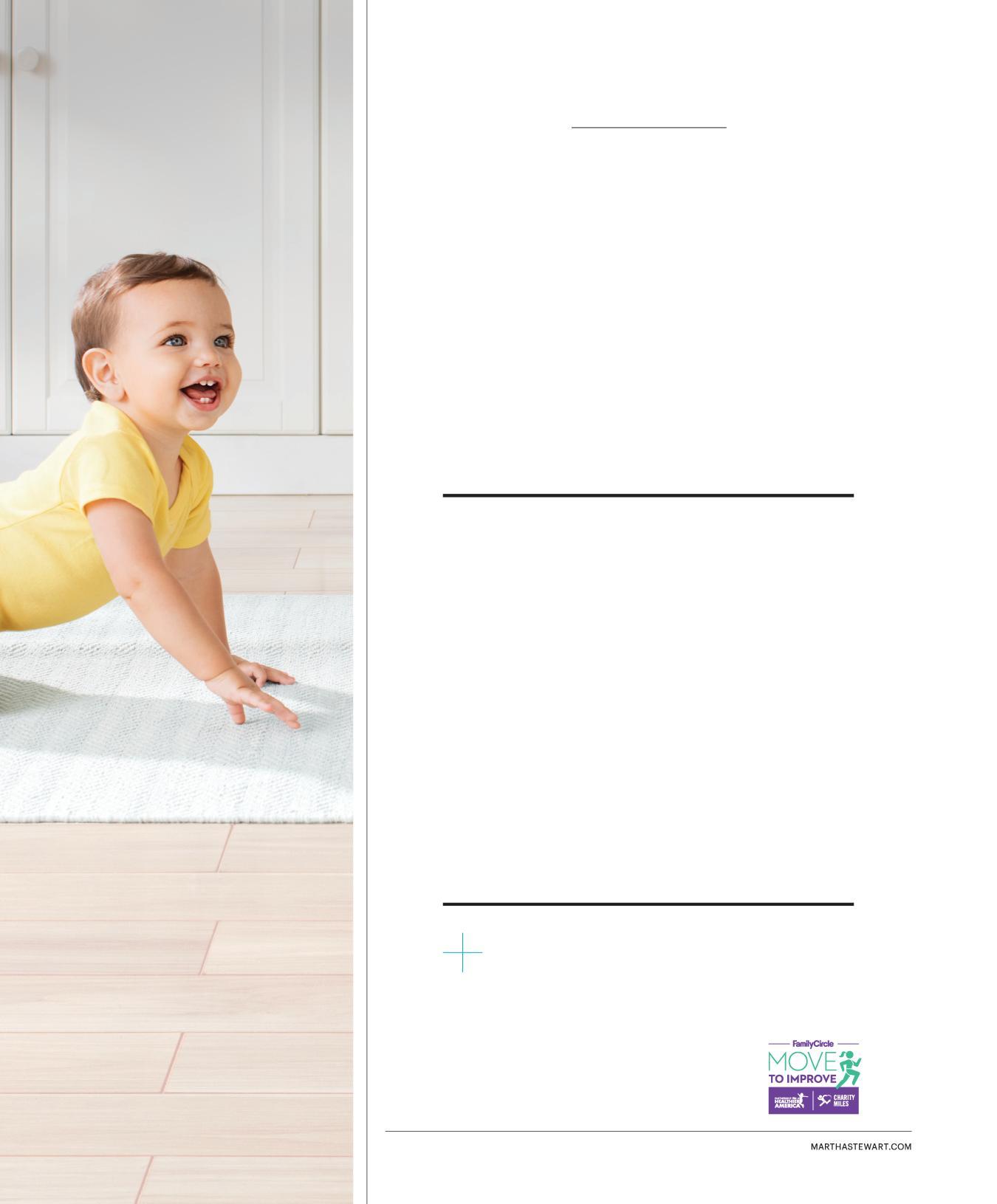
Health
GOOD LIVING
THE CAVEAT: Your doctor can’t hack into your Fitbit to find out how winded you were on that last hill (at least, not yet). FINE-TUNE IT: The American Heart Association (AHA) now recommends that cardiorespiratory fitness, which measures how well your body circulates oxygen to tissues, be tracked like other key vital signs. “Evidence suggests that it’s just as important as—if notmoresothan—traditionalcardiovascular risk factors” such as high blood pressure, says Leonard Kaminsky, Ph.D., coauthor of the AHA’s statement and director of Ball State University’s Fisher Institute of Health and Well-Being. There isn’t an in-office test yet, so ask for a referral to a clinic that offers treadmill tests to quantify maximum oxygen consumption. If your numbers fall below the normal range, amp up your exercise. Any heart-rate booster, even a brisk 15-minute walk, counts.
The Stress Test
Doctors don’t always ask direct questions about your stress level at a checkup, but this may soon be a common practice. Isolated instances of anxiety, like when you’re battling bad traffic or giving a high-stakes presentation, are normal: They trigger the body’s fight-or-flight instincts and temporarily flood your system with the stress hormone cortisol. Problems start when your cortisol levels get stuck on high. Chronically elevated cortisol can lead to inflammation in the body, which, over time, ups your chances of heart disease and stroke. But your doc doesn’t have a way to measure that kind of sustained stress—just its effects on your body.
What she can do is ask whether you’ve felt down or depressed in the past week. “That’s one of two new questions our doctors are now required to ask at all outpatient primary-care offices, regardless of the reason a patient has come in,” says the Cleveland Clinic’s Amber Tully; the other is whether you’ve been having trouble concentrating. If the answer to either is yes, doctors follow with detailed questions about sleep and focus, in order to gather objective data on whether you may have undiagnosed anxiety or depression. If you have symptoms, counseling is offered and recommended.
“Even if all your other numbers are normal, you may be worried all the time, so your body is in overdrive,” says Tully. “Your heart rate might be a little bit elevated. Your blood pressure might still be in the normal range, but higher than average for your age. All of this can lead to an increase in dangerous stress hormones. Asking this question helps us reach people who probably have not been as healthy as they could be.” So if you’re stressed, speak up. Even though it can’t quite be measured, it matters.
Put Your Best Foot Forward
And this year, it can benefit more than just your health:
Our sister brand, FamilyCircle, has teamed up with the nonprofit Partnership for a Healthier America on a program called Move to Improve, and we want you to help us log 20.17 million miles to fight childhood obesity. Download the free Charity Miles app and select “P artnership for a Healthier America.” Learn more at charitymiles.org/movetoimprove.
Editors’ Picks
GOOD LIVING
Knit Picks
Soft, toasty, and way cozy, cashmere socks from Garnet Hill are a real treat for your feet. From $34, garnethill.com.
WIN THIS!
You could own this cup! Visit marthastewart .com/winthis on March 9 to enter for your chance to win. For more details, see page 117.
Pretty Pour
This handcrafted porcelain cup by artisan Christiane Perrochon makes your morning tea or coffee ritual elegant. $95, abchome.com.
Fine Finishes
Drizzle one of these unfiltered Greek extra-virgin olive oils from Kolossos over pasta and salads. One is mild, the other robust. $38 for set of 2, food52.com.
Sweet Sip
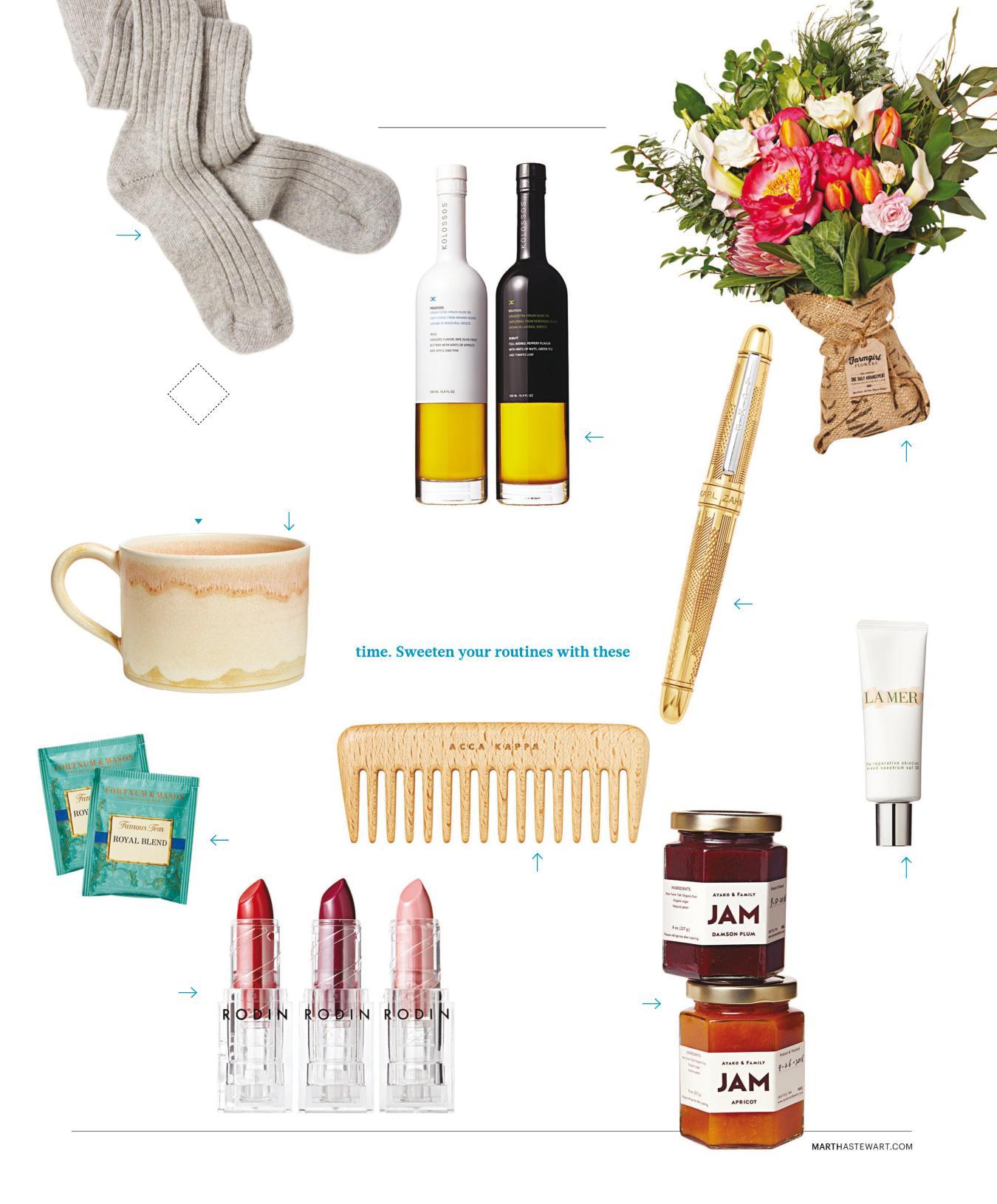
Mixed for King Edward VII, Fortnum & Mason’s Royal Blend combines Ceylon and Assam teas for a honey-like brew. $30, williams-sonoma.com.
LITTLE LUXURIES
It’s the simple yet special things we reach for daily—a beautiful cup, a luminous moisturizer, featherweight cashmere socks—that give us a happy lift every
well-worth-it splurges.
PHOTOGRAPHS BY PETER ARDITO
Luxe Lips
Rodin‘s five iconic lipstick shades are perfectly curated and impart color infused with rich essential oils. $38 each, oliolusso.com.
Smooth Operator
Made from beechwood, which calms static, Acca Kappa’s wide-tooth comb is also gentle on hair and the scalp. $28, shopaccakappa.com.
Well Preserved
Organic fruit picked at their flavor’s peak makes small-batch jams by Ayako & Family shine. From $14 each, ayako andfamily.com.
Domestic Bliss
Have a gorgeous fresh bouquet—grown in the U.S. and made by Farmgirl Flowers— sent right to your door. From $45, farm girlflowers.com.
Signature Style
With a chic brass rollerball pen designed by Karl Zahn, scribbling a grocery list never felt so glamorous. $104, acmestudio.com.
Glow Pro
Loaded with some of the same nutrients in the cult cream but at a fraction of the price, La Mer the Reparative SkinTint comes in five shades and has SPF 30. $95, lamer.com.
Ask Martha
GOOD LIVING
Q:
I’m getting ready to move. How can I alleviate my cat’s anxiety in the new space?
—Mary Mathis, Athens, Ga. A: Most cats are nervous about any change in their environment, so it’s important to help them acclimate to a new one. On moving day, keep your pet in an empty room with food, water, a litter box, and an open carrier, and tape a note to the door letting the movers know not to enter it. Then, as you’re settling in, set up a safe, quiet room in your new place, and use a spray like Comfort Zone Feliway Diffuser Kit ($37, amazon.com), which mimics the scent of natural pheromones, to get your cat comfortable and help prevent her from urinating outside her litter box. When she’s ready to explore, keep an eye on her—moving her back to the safe space if she displays naughty behavior, like scratching—and place a second litter box somewhere nearby.


